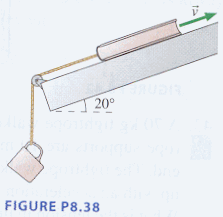CHAPTER 8
- (P.230 Prob.16) A massive steel cable drags a 20-kg block across a
horizontal, frictionless surface. A 100-N force applied to the cable causes
the block to travel 4.0 m in a distance of 2.0 m. What is the mass of the
cable?
- (P.231 Prob.28) The lower block in Figure P8.28 is pulled on by a rope with
a tension force of 20 N. The coefficient of kinetic friction between the lower
block and the surface is 0.30. the coefficient of kinetic friction between the
lower block and the upper block is also 0.30. What is the acceleration of the
2.0-kg block?

- (P.231 Prob.38) The 1.0-kg physics book in Figure P8.38 is connected by a
string to a 500-g coffee cup. the book is given a push up the slope and
released with a speed of 3.0 m/s. The coefficients of friction are μs
= 0.50 and μk = 0.20.
a. How far does the book slide?
b.
At the highest point, does the book stick to the slope, or does it slide back
down?

- (P.233 Prob.49) Challenge Problem. Figure CP8.49 shows a 200 g
hamster sitting on an 800 g wedge-shaped block. The block, in turn , rests on
a spring scale.
a. Initially, static friction is sufficient to keep the
hamster from moving. In this case, the hamster and the block are effectively a
single 1000 g mass and the scale should read 9.8 N. Show that this is the case
by treating the hamster and the block as separate systems and analyzing
the forces.
b. An extra-fine lubricating oil having μs = μk =
0 is sprayed on the top surface of the block, causing the hamster slide down.
Friction between the block and the scale is large enough that the block does not
slip on the scale. What does the scale read as the hamster slides down?



